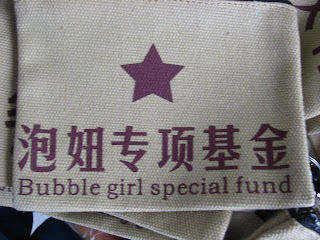On August 3 I went to Beijing. The train rode overnight, for almost a complete day. On the way I met a couple of Chinese university students. One of them was a girl who was studying in Kansas and played on a baseball team. The other one was a guy who said he was going up to Beijing to break up with his girlfriend. Both of them spoke decent English and talked to me for a long time, and helped me out a little about what to do when I got to Beijing.
The first day in Beijing, there wasn't much time, so I stayed around the hostel, and looked up things about China and planned my next moves. Some of the other people in the room invited me out to eat that night. At the restaurant we also met a girl who had visited North Korea.
 |
| Beijing Railway Station |
Tiananmen Square
The second day was dedicated to the center of the city. Tiananmen Square, the main public space in Beijing, sits right in front of the old imperial palace, the Forbidden City (also known as the Palace Museum). As a matter of fact, the Forbidden City is only accessible through Tiananmen Square. The place is full of people, including people trying to sell you stuff at inflated prices, with some attractions here and there.
 |
| Building across the street and south of Tiananmen Square |
 |
| Approaching the Square |
 |
| Entering the Square |
 |
| Chinese workers |
 |
| Chinese workers |
 |
| Mao Zedong's Mausoleum |
Perhaps because Communists are materialists, they seem to have an almost Egyptian obsession with preserving the physical remains of their leaders. Chairman Mao's body is enshrined here, where the public is free to gaze at him. But only for a couple of hours in the morning. Then it's closed. I got there just too late, and never got to see the corpse.
The Forbidden City
Tiananmen Square was huge, making the approach to the Forbidden City very drawn out and confusing. Every time I passed through a gate or wall I'd think I was about to enter the Forbidden City, only to find myself in another square, empty except for other people, and realize I had to walk all the way to another wall, where, hopefully, it would be the Forbidden City. Of course, I did eventually get there, and when I did I knew it. It confirms the old wisdom, "You're not really there until there's a ticket counter with a line of people."
 |
| Approaching the Forbidden City |
 |
| The Forbidden City's Nameplate |
 |
| Eaves of the Forbidden City |
 |
| Quadrilingual inscription in Tibetan, Mongolian, Manchurian, and Chinese |
|
 |
| Grass on an imperial roof |
 |
| The Emperor's Garden |
 |
| Exit of the Forbidden City |
 |
| Moat of the Forbidden City |
Jingshan Park
When I left the Forbidden City, I felt it was still too early to call it a day, but I wasn't sure what I should see next. There was a sign with a list of other sites of interest, including their directions and distances from the Forbidden City. Most of them were fairly far away, or large, or something else. One of them, though, was Jingshan Park (景山). I'd never heard of it before, but it was directly behind the Forbidden City across the street, far closer than any of the other sites, so I decided to go there. It was fortuitous, because the place turned out to be very interesting, and borderline surreal.
Following a winding path, I made a large semicircle around to the back, and encountered many large dinosaur sculptures.
 |
| Raptors rush in for the kill, as children and old people stroll by |
The park was alive with many active and sometimes eccentric characters, alone or in groups, playing instruments, singing, dancing, or practicing martial arts (perhaps).
 |
| Dancing Couple, and some random gawking tourists |
 |
| Singers |
After I followed my ears to choir above, I noticed I was at the foot of a large hill with a pagoda-like structure at the top, so I climbed it.
 |
| View from below |
Up there were some people selling various items. I bought some fans for my Mongolian friends. I admired, but did not buy, the canvas purses and wallets shown below.
 |
| Peace Corps volunteers can relate |
 |
| Ironically, this was the only perfectly acceptable English sentence |
Once ascended, the hilltop pavilion turned out to possess an incredible panoramic view of Beijing, due to its height, and its location at the geographical center of the city.
 |
| Looking back at the Forbidden City from above |
 |
| The Forbidden City |
 |
| Self-explanatory |
 |
| Beijing, to the East |
 |
| To the northeast, the imperial lakes |
 |
| The pavilion itself |
One group of businesswomen had sets of traditional costumes, and for a few bucks, I got my picture taken on a throne, posing as an emperor of the Manchu Qing Dynasty.
 |
| Andrew Huangdi |
By the time I left, it was getting dark. On the way back, I saw this radiant white blobular globe, which I believe is a theatre. It was a long walk back to the hostel.
I fell asleep easily and made ready for the next few days of temples, palaces, pandas, and assorted ancient Chinese cultural experiences...


















































What an experience you had in Bejing. It seems that you saw quite a lot while there. The white globe is beautiful at night. I know you are writing everything in your journal.
ReplyDelete